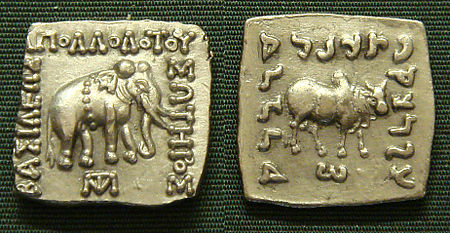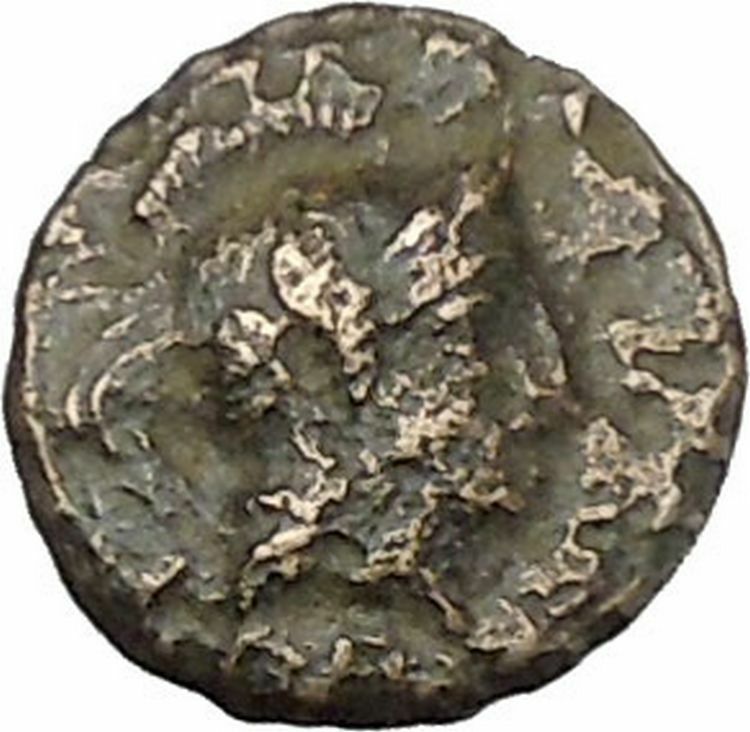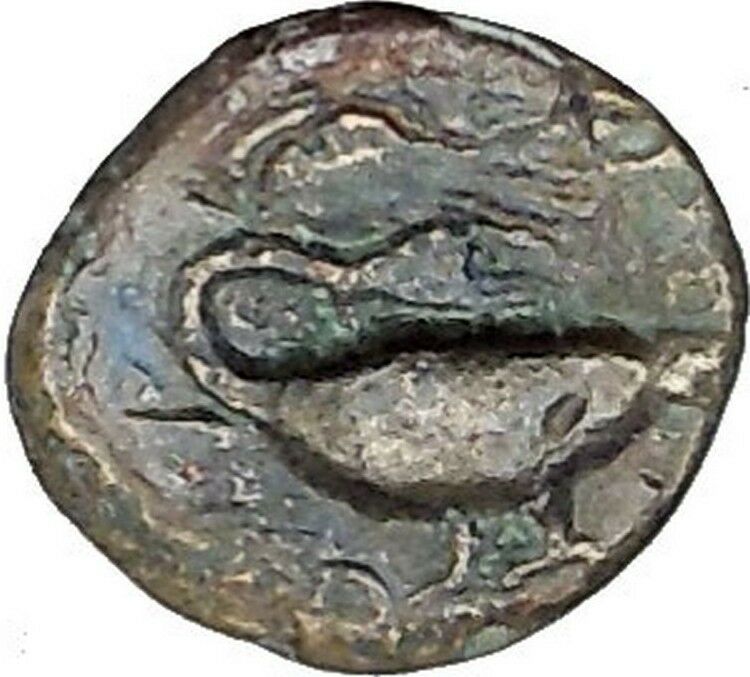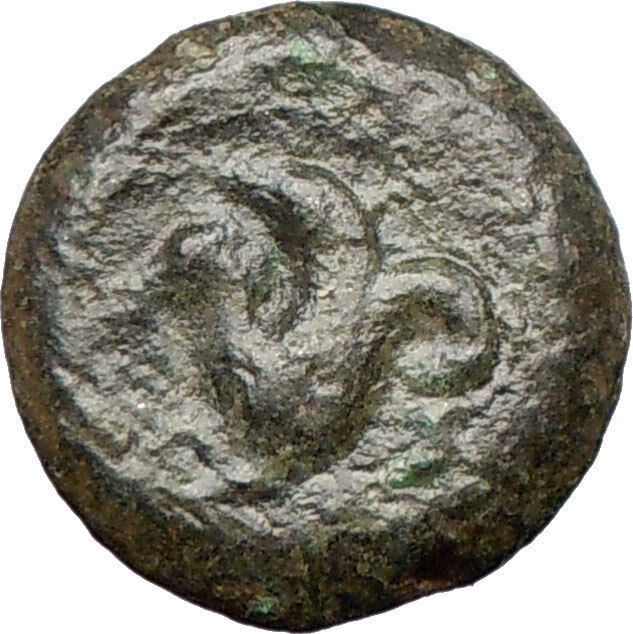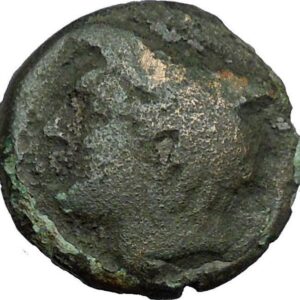|
Baktrian Indo Greek Kingdom in
India
Apollodotos I – King, circa 174-165 B.C.
Bronze 25mm (6.58 grams) Uncertain mint in the Paropamisadai or Gandhara
Reference: HGC 12, 120; Bopearachchi Serie 6.1-94
ΒΑΣΙΛΕΩΣ /
AΠΟΛΛΟΔΟΤΟΥ / ΣΩTHPOΣ,
Apollo standing facing, holding arrow and grounded bow.
(Maharajasa Apaladatasa tradarasa [of Great King
Apollodotos the Savior]) around tripod; monogram in field.
You are bidding on the exact item pictured,
provided with a Certificate of Authenticity and Lifetime Guarantee of
Authenticity.
A sacrificial tripod is a three-legged piece of religious furniture
used for offerings or other ritual procedures. As a seat or stand, the
tripod
is the most stable furniture
construction for uneven ground, hence its use is universal and ancient. It is
particularly associated with
Apollo
and the
Delphic oracle
in
ancient Greece
, and the word “tripod” comes
from the Greek meaning “three-footed.”

Apollo and
Heracles
struggle for the Delphic
tripod (Attic
black-figure
hydria
, c. 520 BC)
Ancient Greece
The most famous tripod of ancient Greece was the
Delphic
tripod from which the
Pythian priestess
took her seat to deliver the
oracles
of the deity. The seat was formed by a
circular slab on the top of the tripod, on which a branch of
laurel
was deposited when it was unoccupied by
the priestess. In this sense, by Classical times the tripod was sacred to
Apollo
. The
mytheme
of
Heracles
contesting with Apollo for the tripod
appears in vase-paintings older than the oldest written literature. The oracle
originally may have been related to the primal deity, the Earth.
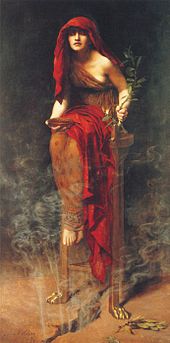
Priestess of Delphi (1891), as imagined by
John Collier
; the Pythia is
inspired by
pneuma
rising from below as she
sits on a tripod
Another well-known tripod in Delphi was the
Plataean Tripod
; it was made from a tenth part
of the spoils taken from the
Persian
army after the
Battle of Plataea
. This consisted of a golden
basin, supported by a
bronze
serpent
with three heads (or three serpents
intertwined), with a list of the states that had taken part in the war inscribed
on the coils of the serpent. The golden bowl was carried off by the
Phocians
during the
Third Sacred War
(356–346 BC); the stand was
removed by the emperor
Constantine
to
Constantinople
in 324, where in modern
Istanbul
it still can be seen in the
hippodrome
, the Atmeydanı, although in
damaged condition: the heads of the serpents have disappeared, however one is
now on display at the nearby Istanbul Archaeology Museums. The inscription,
however, has been restored almost entirely. Such tripods usually had three
ears (rings which served as handles) and frequently had a central upright as
support in addition to the three legs.
Tripods frequently are mentioned by
Homer
as prizes in
athletic games
and as complimentary gifts; in
later times, highly decorated and bearing inscriptions, they served the same
purpose. They also were used as dedicatory
offerings
to the deities, and in the dramatic
contests at the Dionysia
the victorious
choregus
(a wealthy citizen who bore the
expense of equipping and training the chorus) received a crown and a tripod. He
would either dedicate the tripod to some deity or set it upon the top of a
marble structure erected in the form of a small circular temple in a street in
Athens
, called the street of tripods,
from the large number of memorials of this kind. One of these, the
Choragic Monument of Lysicrates
, erected by him
to commemorate his victory in a dramatic contest in 335 BC, still stands. The
form of the victory tripod, now missing from the top of the Lysicrates monument,
has been rendered variously by scholars since the 18th century.
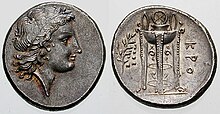
An ancient Greek coin c. 330-300 BC. Laureate head of Apollo (left)
and ornate tripod (right).
Martin L. West
writes that the sibyl at Delphi
shows many traits of
shamanistic
practices, likely inherited or
influenced from Central Asian practices. He cites her sitting in a cauldron on a
tripod, while making her prophecies, her being in an ecstatic trance state,
similar to shamans, and her utterings, unintelligible.
According to Herodotus (The Histories, I.144), the victory tripods were not
to be taken from the temple sanctuary precinct, but left there as dedications.
Sometimes the tripod was used as a support for a
lebes
or cauldron or for supporting other items
such as a vase.
-
Delphic tripod (red-figured
bell-krater
,
Paestum
, c. 330 BC)
Ancient China
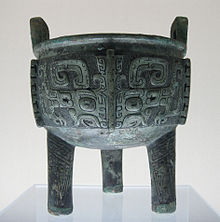
A
ding
from the late
Shang Dynasty
.
Tripod pottery have been part of the archaeological assemblage in China since
the earliest Neolithic cultures of
Cishan
and
Peiligang
in the 7th and 8th millennium BC.
Sacrificial tripods were also found in use in ancient
China
usually cast in bronze but sometimes
appearing in ceramic form. They are often referred to as “dings”
and usually have three legs, but in some usages have four legs.
The Chinese use sacrificial tripods in modern times, such as in 2005, when a
“National Unity Tripod” made of bronze was presented by the central Chinese
government to the government of northwest China’s
Xinjiang Uygur Autonomous Region
to mark its
fiftieth birthday. It was described as a traditional Chinese sacrificial vessel
symbolizing unity.

In
Greek
and
Roman mythology
,
Apollo,
is one of the most important and diverse of the
Olympian deities
. The ideal of the
kouros
(a beardless youth), Apollo has been
variously recognized as a god of light and the sun; truth and prophecy;
archery
; medicine and healing; music, poetry,
and the arts; and more. Apollo is the son of
Zeus and Leto
, and has a
twin
sister, the chaste huntress
Artemis
. Apollo is known in Greek-influenced
Etruscan mythology
as Apulu. Apollo was
worshiped in both
ancient Greek
and
Roman religion
, as well as in the modern
Greco
–Roman
Neopaganism
.
As the patron of Delphi
(Pythian Apollo), Apollo was an
oracular
god — the prophetic deity of the
Delphic Oracle
. Medicine and healing were
associated with Apollo, whether through the god himself or mediated through his
son Asclepius
, yet Apollo was also seen as a god
who could bring ill-health and deadly
plague
as well as one who had the ability to
cure. Amongst the god’s custodial charges, Apollo became associated with
dominion over
colonists
, and as the patron defender of herds
and flocks. As the leader of the
Muses (Apollon Musagetes) and director of their choir, Apollo
functioned as the patron god of music and
poetry
.
Hermes
created the
lyre for him, and the instrument became a common
attribute
of Apollo. Hymns sung to Apollo were
called paeans
.
In Hellenistic times, especially during the third century BCE, as Apollo
Helios he became identified among Greeks with
Helios
,
god of the sun
, and his sister Artemis
similarly equated with
Selene
,
goddess of the moon
. In Latin texts, on the
other hand, Joseph Fontenrose declared himself unable to find any conflation of
Apollo with
Sol
among the
Augustan poets
of the first century, not even
in the conjurations of
Aeneas
and
Latinus
in
Aeneid
XII (161–215). Apollo and Helios/Sol
remained separate beings in literary and mythological texts until the third
century CE.
Apollodotus I Soter (Greek:
Ἀπολλόδοτος Α΄ ὁ Σωτήρ; the
epithet
means the “Saviour”;
Sanskrit
: महरजस अपलदतस त्रतरस, “maharajasa
apaladatasa tratarasa”) was an
Indo-Greek
king between 180 BCE and 160 BCE or
between 174 and 165 BCE (first dating Osmund
Bopearachchi
and R. C. Senior, second dating
Boperachchi) who ruled the western and southern parts of the Indo-Greek kingdom,
from Taxila
in
Punjab
to the areas of
Sindh
and possibly
Gujarat
.
Ruler of the
Indo-Greek kingdom
Apollodotus was not the first to strike bilingual coins outside of Bactria,
but he was the first king who ruled in India only, and therefore the founder of
the proper Indo-Greek kingdom. According to
W. W. Tarn
, Apollodotus I was one of the
generals of
Demetrius I of Bactria
, the
Greco-Bactrian
king who invaded northwestern
India
after 180 BCE. Tarn was uncertain whether
he was a member of the royal house. Later authors largely agree with Tarn’s
analysis, though with perhaps even more uncertainty regarding who the king was,
for his coins do not give many hints.
Apollodotus was either succeeded in India by
Antimachus II
, or the two kings were
contemporary, Antimachus II ruling the more western territories closer to
Bactria. Eventually Apollodotus I was succeeded by
Menander I
, and the two kings are mentioned by
Pompejus Trogus as important Indo-Greek rulers.
The 1st-2nd century CE
Periplus of the Erythraean Sea
further
testifies to the reign of Apollodotus I and the influence of the
Indo-Greeks
in India:
“To the present day ancient drachmae are current in
Barygaza
, coming from this country, bearing
inscriptions in Greek letters, and the devices of those who reigned after
Alexander, Apollodorus [sic] and
Menander
.”
—Periplus Chap. 47.
Coinage
Indian-standard coin of Apollodotus I.
Obv: Sacred elephant with decorative belt and
Greek
legend ΒΑΣΙΛΕΩΣ ΑΠΟΛΛΟΔΟΤΟΥ
ΣΩΤΗΡΟΣ, “of Saviour King Apollodotus”.
Rev: Zebu
bull with
Kharoshti
legend 𐨨𐨱𐨪𐨗𐨯
𐨀𐨤𐨫𐨡𐨟𐨯 𐨟𐨿𐨪𐨟𐨪𐨯 (MAHARAJASA APALADATASA TRATARASA), “Saviour
King Apollodotus”.
Actual size: 15 mm, 1.4 grams.
Indian coin of Apollodotus I.
The coinage of Apollodotus is, together with that of Menander, one of the
most abundant of the Indo-Greek kings. It is found mainly in the provinces of
Punjab, Sindh
and
Gujarat
, indicating the southern limit of the
Indo-Greek expansion in India. This is also suggested by the
Periplus
, a 1st-century CE document on trade in
the Indian Ocean
, which describes the remnants of
Greek presence (shrines, barracks, wells, coinage) in the strategic port of
Barygaza (Bharuch)
in Gujarat. Strabo
(XI) also describes the occupation of
Patalene (Indus
Delta country). While Sindh may have come under his possession, it is not known
as to whether Apollodotus advanced to Gujarat, where the Satavahanas ruled.
Apollodotus also issued a great number of bilingual Indian-standard square
coins. Beside the usual royal title, the exact significance of the animals
depicted on the coins is unclear. The sacred elephant may be the symbol of the
city of Taxila
, or possibly the symbol of the white
elephant who reputedly entered in dream the womb the mother of the
Buddha
,
Queen Maya
, which would make it a symbol of
Buddhism
, one of the main religions of the
Indo-Greek territories.
Similarly, the sacred bull on the reverse may be a symbol of a city (Pushkhalavati),
or a depiction of Shiva
, making it a symbol of
Hinduism
, the other major religion at that
time. The bull is often represented in a clearly erectile state, which
reinforces its interpretation as a representation of Shiva. Conversely, this
also reinforces the interpretation of the elephant as a religious symbol.
Alternatively, the Bull, according to
Foucher
, represents the birth of the Buddha, as
it happened during the month of Vaicakha (April–May), known to Buddhists
as Vesak
, under the zodiacal sign of the
Taurus
, during the full moon. The enlightenment
and passing of the Buddha also occurred during the Taurus full moon.
Before their design was eventually simplified, some of the earlier coins of
king Apollodotus directly associate the elephant with Buddhist symbolism, such
as the stupa
hill surmounted by a star, also seen, for
example on the coins of the
Mauryan Empire
or those of the later
Kuninda kingdom
. Apollodotus experimented with
different coin standards for his silver, until he settled for a standard lighter
than the Attic which would prevail for centuries, though later rulers usually
struck round coins instead of the square (typically Indian) shape of most of
Apollodotus’ silver. He issued a number of bronzes with
Apollo
/tripod, that also were repeated for
centuries.
Bactrian coins
Apollodotus also issued a small series of monolingual Attic tetradrachms,
intended for export into Bactria. For these, Apollodotus I clearly used Bactrian
celators to strike an exquisite realistic portrait of the king as an aged man in
the Macedonian hat called kausia, with a reverse of sitting
Pallas Athene
holding
Nike
, a common Hellenistic motif introduced by
the
Diadoch
Lysimachus
. On these coins, he used no epithet.
Preceded by:
(In
Paropamisade
)
Agathocles
(In Gandhara
)
Pantaleon
|
Indo-Greek Ruler
(Paropamisade,
Arachosia
,
Gandhara
,
Punjab
)
180–160 BCE |
Succeeded by:
Antimachus II
|
|












